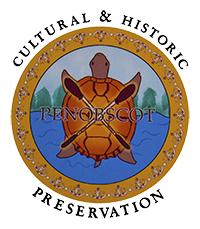penawahpskewi
Indian Nation
We, the Penobscot people, are indigenous to Penobscot watershed. We are included in the term Wabanaki, which is used to denote the sovereign nations of Maine and the Maritimes, exclusively in the European boundaries of Maine, New Brunswick, and Nova Scotia. The early European explorers found a powerful confederacy upon their arrival. One of our first recorded
leaders, the powerful Chief Bessabez, or Bashaba as the English called him, ruled a nation of over twenty villages, where the confederacy dominated. From 1606 to 1616, the region was subject to inter-tribal conflict and invasion. Bessabez was killed and immediately following was an apocalyptic time of pestilence, believed to be European introduced smallpox, that began to decimate our indigenous populations. This was furthered by the long wars with the Mohawks from the 1630's until 1678. Penobscot numbers were estimated to be over 10,000 - but by 1803 - only 347 Penobscots remained.
Increased warfare between English settlers and the Native people took place between 1675 and 1760. Most of this was a result of the battle for control by the French and English. During this period, the Wabanaki Confederacy allied with the French, which had been the friendlier trading ally, while the English formed a strong military alliance with the Iroquois Confederacy. The French and their native allies made peace with the English after the 1760 war - but the wars had exhausted a lot of the strength of the Wabanaki Nations and their resources.
At the request of George Washington, the Penobscot sided with the American colonists in the Revolutionary War, but would soon be largely forgotten. This trend continued even as Penobscot people had faithfully served in every major U.S. war and conflict. Treaties were made between each of the two major tribes, the Penobscots and Passamaquoddys, and the Commonwealth of Massachusetts. These treaties pertained largely to lands, goods, and services to be provided by the new state.
Becoming a state in 1820, Maine assumed these treaty obligations, but reneged and appropriated a majority of the indigenous lands. These actions were in violation ofthe Federal Trade and Non-Intercourse Act of 1790, which forbid the transfer of Penobscot land without the consent of Congress, and were the basis for the 1980 lands claims suit against the state and the federal government.
In 1965, Maine became the first state in the U.S. to create a separate Department of Indian Affairs. Throughout its 15 year history, the agency was chronically underfunded, and displayed the state's non-recognition of Penobscot sovereignty. The building in which our museum is now housed originally served as the Maine Indian Agent's office ..from which food and service vouchers were distributed to tribal members, while the remaining resources were embezzled by the white agents. In the 1950's, Penobscots were able to have their own agents, and the illegal process was rectified.
In the 1960's litigation was being considered by the Passamaquoddy and Penobscot tribal members soon pushed to have their claims added to the eventual Land Claims based on the violation of the 1790 NonIntercourse Trade Act. This lead to prolonged legal battles and public smear campaigns against the Penobscot and Passamaquoddy. After this created a sense of fear and reprisal, the tribes signed a settlement.
Since the settlement, the tribes are indeed better off than before, but this has come at a heavy cost to their overall health and safety. The discrete negotiations between the State and Federal administrators at the time also left the rights and amenities of the Penobscot people in question and open to continued manipulation at the whim of state officials. The Penawahpskewi remain strong in our identity and connection to the river and lands that has given us life for thousands of years.
